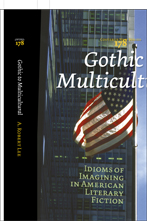
A.Robert LEE, Gothic to Multicultural. Idioms of Imagining in American LiteraryFiction.
Amsterdam/New York, NY: Rodopi coll. "Costerus" (NS) n° 178, 2009, 543 pp.
- Isbn 13 (ean):978-90-420-2499-1
Présentation de l'éditeur:
Gothic to Multicultural: Idioms of Imagining inAmerican Literary Fiction, twenty-three essays each carefully revised from the past four decades,explores both range and individual register. The collection opens withconsiderations of gothic as light and dark in Charles Brockden Brown, war andpeace in Cooper's The Spy, Antarctica as world-genesis in Poe's The Narrativeof Arthur Gordon Pym, the link of “The Custom House” and main text inHawthorne's The Scarlet Letter, reflexive codings in Melville's Moby-Dick andThe Confidence-Man, Henry James' Hawthorne as self-mirroring biography, andStephen Crane's working of his Civil War episode in The Red Badge of Courage. Twocomposite lineages address apocalypse in African American fiction and landscapein women's authorship from Sarah Orne Jewett to Leslie Marmon Silko. Therefollow culture and anarchy in Henry James' The Princess Casamassima,text-into-film in Edith Wharton's The Age of Innocence, modernist stylings inFitzgerald, Faulkner and Hemingway, and roman noir in Cornell Woolrich. Thecollection then turns to the limitations of protest categorization for RichardWright and Chester Himes, autofiction in J.D. Salinger's The Catcher in the Rye, and the novel of ideas in RobertPenn Warren's late fiction. Three closing essays take up multiculturalgenealogy, Harlem, then the Black South, in AfricanAmerican fiction, and the reclamation of voice in Native American fiction.
Table des matières:
Acknowledgements
Introduction:Pathways, Bearings
1. ADarkness Visible: Gothic and the Case of Charles Brockden Brown
2. MakingHistory, Making Fiction: Cooper's The Spy
3. Impudentand Ingenious Fiction: Poe's The Narrative of Arthur Gordon Pym of Nantucket
4. Like aDream Behind Me: Hawthorne's “The Custom-House” and The Scarlet Letter
5. TheMirrors of Biography, The Mirrors of Fiction: Henry James' Hawthorne
6.Moby-Dick as Anatomy
7. VoicesOff, On, and Beyond: Ventriloquy in The Confidence-Man
8. StephenCrane's The Red Badge of Courage: The Novella as Moving Box
9. Hell'sLoose: Apocalypse in the Early and Modern African American Novel
10. Woman'sPlace? The Landscapes of Jewett, Chopin, Cather, Hurston, Welty, Chávez,Yamashita, Silko
11. Odd ManOut? Henry James, The Canon and The Princess Casamassima
12.Watching Manners: Martin Scorsese's The Age of Innocence, Edith Wharton's TheAge of Innocence
13. AQuality of Distortion: Imagining The Great Gatsby
14.Everything Completely Knit Up: Seeing For Whom the Bell Tolls Whole
15.Modernist Faulkner? A Yoknapatawpha Trilogy
16. TheView from the Rear Window: The Fiction of Cornell Woolrich
17. RichardWright's Inside Narratives
18.Violence Become a Form: The Novels of Chester Himes
19.Flunking Everything Else Except English Anyway: Holden Caulfield, Author
20. ThePlace We Have Come To: The Late Fiction of Robert Penn Warren
21. Harlemon My Mind: Fictions of a Black Metropolis
22. DownHome: Mapping The South in Contemporary African American Fiction
23. I AmYour Worst Nightmare: I Am an Indian with a Pen – Fictions of the Indian,Native Fictions
Index
A. RobertLee is Professor of American Literature at Nihon University, Tokyo, having previously taught at the University of Kent, UK. His publications include Designsof Blackness: Mappings in the Literature and Culture of Afro-America (1998),Multicultural American Literature: Comparative Black, Native, Latino/a andAsian American Fictions (2003), which won the American Book Award for 2004,Japan Textures: Sight and Word, with Mark Gresham (2007), and United States:Re-viewing Multicultural American Literature (2008).